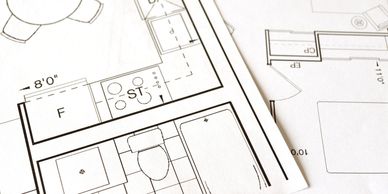Choosing Land for Your Home
When it comes time to find a suitable piece of property (land) on which to build a home, there are a number of things that you need to be aware of. These can be divided into two categories: Physical Characteristics and Legal Considerations.
Physical Characteristics
- Access
- Size
- Topography
- Drainage
- Utilities
- Trees
- Hidden Features
Access
Topography
Topography

If the house is being built in a subdivision or on a city lot, access to the property is largely pre-determined. If the land is in a rural area, the length and the grade of the driveway are serious considerations. A long driveway with a steep grade can be an expensive maintenance nightmare and may also require the installation of drainage structures (culverts or bridges) and ditches.
Topography
Topography
Topography
If the building site is fairly flat, the construction process will likely be easier. This applies to both the use of the equipment and the storage of lumber or other materials. If the site is the side of a hill, more careful consideration and planning will be required, not only for the home construction but also for the running of utilities and drainage.
Drainage
Topography
Drainage

This is definitely one of the most important things to consider, especially close to the home. The land needs to slope away from home on all sides to keep water away from the foundation or basement. If the house is built on a large slope, there should be a swale or ditch constructed uphill to catch water before it reaches the house. Also, any new ditches or new elevation changes to the property should never be allowed to create drainage problems for neighbors.
Trees
Hidden Features
Drainage
If your lot or land has large trees that will be in close proximity to the new home, it may be worth spending the money to have them removed. Limbs overhanging the house can break and fall, doing considerable damage to the roof, among other things. Tree roots can destroy sidewalks and penetrate foundations and drains, resulting in expensive repairs. Leaves, seeds, and other tree debris can fill gutters along the roof of the home, causing water to spill over and end up next to the foundation.
Hidden Features
Hidden Features
Hidden Features

This can include any number of things that you can't see until you start digging. Some Examples: Large rock formations under the surface that could either be expensive to remove or even prevent a home from being built. Or, how about undocumented but active drainage lines from the property next door that was installed when someone in the past owned both lots. Or, maybe, huge tree stumps or large chunks of concrete buried years ago that will have to be removed and disposed of.
Utilities
Utilities
Utilities
Typically, city or subdivision lots have all necessary utilities available on or near the lot. This may or may not include natural gas, depending on the location. Some rural properties may have no utilities nearby. First and foremost, make sure you can get electricity run to the property. Depending on the distance and number of poles needed, this can cost several thousand dollars.
If public water isn't available, you may have to look at drilling a well. Find out if this is even feasible at your location. This can also be very expensive. Lastly, if a public sewer isn't available, you will need to install a septic system. You'll need to find out if your property has a large enough area or proper soil for a leaching field and, if not, if there are other alternatives (such as an aerator system).
Size
Utilities
Utilities
A city or subdivision lot is already laid out to a specific size. It's just a matter of finding the home plan that fits well on the lot while leaving sufficient space around the exterior for maintenance. Also, arrangements may need to be made to dispose of excess soil from the excavation, especially if a basement is planned.
If the property is large enough, such as in a rural area, there may be plenty of room to spread the excess material on the property (check local regulations first). If you plan on buying land to be split from a larger piece of real estate, here's some info for you: One Acre = 43,560 square feet. If the property is roughly a rectangle, you can determine the acreage as in this example: 200' length x 350' width = 70,000 sq. ft. / 43,560 = 1.61 acres
Legal Considerations
- Surveys
- Restrictions
- Setbacks
- Easements
- Deeds & Plats
- Permits
Restrictions
Restrictions
Restrictions

Deeds, subdivision plats and zoning laws should be checked for any possible restrictions that might include such things as specific sizes or types of outbuildings, raising of animals on the property, large antennas, flagpoles, lawn ornaments, house colors or just about anything else you might think of.
Setbacks
Restrictions
Restrictions

Zoning laws and subdivision plats should also be investigated for setback distances. These determine how close you can build or erect anything to the property line. Even if there are no setback restrictions, you should never put anything permanent directly on or up against the property line. Leave room to maintain any buildings fences or other objects without intruding onto the neighbor's property. Make sure the actual property corners are visible so there won't be a question of where the line really is.
Permits
Restrictions
Permits

Obviously, you will be required to obtain a building permit to start construction on a new home, but there may be other permits you'll need prior to that for such things as driveways, drainage, disposal of excavated materials, etc., etc. Determine the ones you need to apply for and don't attempt to do anything that requires a permit if you don't yet have it.
Surveys
Deeds & Plats
Deeds & Plats

A property survey is an essential component of buying property. A Licensed Professional Land Surveyor should be consulted to determine the exact location of the property corners. There may be monuments already set at the corners, but they can become buried over time and aren't visible. The surveyor can, through the use of public records and sophisticated surveying equipment, locate these monuments on-site.
If the property is being cut (split) from a larger tract, a Surveyor is required to set corner monuments for the new tract and to provide a drawn plat and written legal description of the property. These are used by an attorney to create and file a property deed for the new owner.
I need to point out here the importance of preserving the monuments that have been set by the surveyor. It's a good idea to keep the area around the monuments cleared of debris so that they can be easily found. Chances are you or an adjoining property owner will need to know where they are at some point in the future.
Deeds & Plats
Deeds & Plats
Deeds & Plats

A deed is your legal proof of ownership of the real estate you purchase or are given. It is a written representation, complete with distances and directions of the boundary lines of the property. These reflect the survey plat (drawing) that shows the layout of your land. If the land is a lot in a city addition or a subdivision, the deed may only give the name of the addition/subdivision and the lot number. The actual measurements of the property and other pertinent information would be obtained from the original recorded plat of that specific area.
Disclaimer: This article is for general informational purposes only. Your locale will have its own specific laws, zoning regulations, permits, inspections, etc. concerning real estate and building construction.
Easements
Deeds & Plats
Easements

There are several types of easements. The most common would be for drainage purposes, ingress and egress (entry & exit), utilities, or highways. Typically, an easement allows for public entities to maintain their responsibilities without needing approval from the property owner. In the case of a public highway right-of-way easement, it also allows the public-at-large to use the roadway constructed within the easement. Don't build things on public right-of-way.
There are also private easements for things like ingress and egress. This is typically a strip of land through a portion of one person's property that is of sufficient width to allow an adjoining property owner to get to and from their land (a driveway).